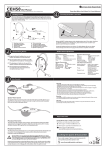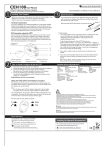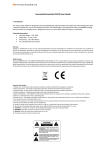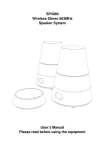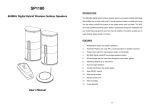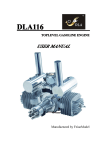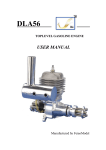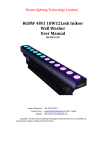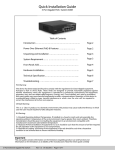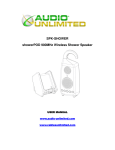Download CES25 Wireless Stereo Speaker System User Manual
Transcript
CES25 Wireless Stereo Speaker System User Manual Please read carefully before using this equipment and retain for future use Introduction This wireless speaker system uses latest wireless technology that enables you to enjoy music, your audio and TV sound anywhere inside or outside* your home. You can simply connect the system to almost any audio source such as Radio, TV, Hi-Fi, CD/MP3/DVD player without complicated wiring or installation. You’ll be enjoying thrilling, lifelike stereo sound in minutes. 863 MHz RF technology stereo speaker system, giving operating distance up to 100m (in ideal conditions) with no line of sight limitation. Virtually interference-free stereo quality sound reproduction. Automatic level control and auto ON/OFF control. Auto tuning – speakers will scan for best signal from receiver. Contents 2 x Speakers 1 x Transmitter 1 x AC/DC 8V 200mA Power Adaptor for Transmitter 2 x AC/DC 9V 1.2A Power Adaptor for Speakers 1 x Audio Cable (RCA male to 3.5 mm Stereo male plug) 1 x Short "Y-Cord" RCA Adapter Cable User’s Manual Getting To Know Your Wireless Speakers 1. Transmitter – connects to your audio equipment and transmits the audio signal to the speakers. 1. 2. 3. 4. 5. 2. 6. 7. 8. 9. 10. 11. 12. 13. Speaker receivers – receive audio from the transmitter. Power On/Off Tune Volume Down Volume Up Battery Door Lock Battery Door DC In, with rubber Cover Power/Signal LED Indicator Getting Started *Keep away from water. Power LED Indicator Signal LED Indicator Audio In Channel Selector DC In For Transmitter Setting Up The Transmitter 1. 2. Plug the supplied power adaptor into the DC socket located on the rear of the transmitter. Plug the supplied AC power adapter into a wall socket. The Power LED will then illuminate. 3. The transmitter can now be connected to audio output of a TV, Radio, CD, MP3 player ipod/iPhone, Smart Phone or DVD players with the cables provided. 4. Once the transmitter detects an audio signal from the source, the SIGNAL LED will illuminate. Setting Up The Speakers 1. Speakers can be powered by batteries (not supplied) or the supplied power adapters. NB You must have a working audio output/source for the transmitter to operate correctly. If using batteries, insert 6 x AA batteries into each speaker battery compartment. If using mains power, connect the supplied power adapters to the input socket at the base of each speaker, then plug into the wall socket. 2. Switch each speaker on by pressing the Power button on top of each speaker. A blue LED light will illuminate when each speaker is switched on. 3. To protect the transmitter and ensure low power consumption, the transmitter will cut off automatically if there is insufficient audio input from the source. Once sufficient signal is restored, the speakers will automatically switch on. *Please Note – you can use standard alkaline or suitable rechargeable batteries. However, the unit does not recharge batteries. Operation 1. 2. 3. 4. 5. Turn on the audio source to which the transmitter is connected with. The Signal LED on transmitter will light up. If it does not, check an audio output is present. Select a channel on the transmitter. You can switch channels for best performance in your location. Press the “POWER” button on the speaker to turn on the speaker. Press the “TUNE” button to get the best tuning reception for the speakers. When the button is pressed, frequency tuning starts automatically and it stops when a signal is detected. Volume can be increased from the speaker by pressing “ + ” button or decreased by pressing the button “ – “. Tuning a) Keep a distance of approximately 7 meters between speaker and transmitter, and then press the TUNE button for the speakers to find the best reception. b). If no signal has been detected, change the channel at the rear of the transmitter and press the TUNE button once again. Note: You should now be able you move from room to room without interference. If interference should occur (the signal cuts off or carries distortion), press the TUNE button on top of the speaker to maximize best reception. The signal from the system will become weaker over longer distances and may break up. Remember, the maximum range of 100 meters is in ideal conditions. Walls, furniture and any other obstruction between the transmitter and speaker(s) will reduce the transmission range. Troubleshooting Please ensure you have set-up your system using the guidelines in this manual. To further help some common problems are also listed below. NO SOUND Ensure the AC adapter is fully inserted into the mains plug and the power connection input is in place on both the transmitter and the speakers. Ensure the speakers are switched on and the blue LED lights illuminate. If using batteries, the capacity may be too low – replace with new batteries or use the supplied AC adapters. Ensure that your connected audio/video equipment is switched on and is operational. Once the transmitter detects the audio signal the SIGNAL LED will illuminate. If in doubt connect the transmitter to an alternative audio source to verify normal operation of the wireless speaker system. Ensure the volume of the wireless speakers is set to an appropriate level. DISTORTED SOUND Distorted Sound may be caused by one or more of the following: Changing the frequency channel – change the position of the channel selector switch on the rear of the transmitter and then press the TUNE button on top of each speaker. Low battery power – if using batteries the capacity may be too low – replace the batteries or use the supplied AC adapters. Speaker volume is set too high – ensure the volume level of the speakers is adjusted properly. The input level of the audio signal is too high/too low – adjust the volume of the audio source equipment. Speaker humming – if you experience a noticeable hum from the speakers, particularly when the audio source equipment is at low volume, reposition the transmitter and associated cables to ensure that these are not in close proximity of mains power cables or mobile telephones. In some instances the audio source equipment may be the source of this interference. If in doubt connect the transmitter to an alternative audio source to verify normal operation of the wireless speaker system. OTHER COMMON PROBLEMS Sound cutting out and/or signal light on transmitter not illuminating – the transmitter requires a minimum signal level from the audio source equipment. Increase the volume of the audio source equipment until the SIGNAL LED on the transmitter is constantly illuminated. Interference or background hiss – this is caused by amplification of a low signal level from the audio source equipment. Increase the volume of the audio source equipment whilst reducing the volume setting of both speakers using the speaker volume controls. Specifications Transmission Mode: Carrier Frequency: Operation Voltage: UHF stereo 863 MHz Transmitter – AC/DC 8V 200mA Power Adapter Speaker – AC/DC 9V 1.2A Power Adapter or 6 x AA size Alkaline Batteries (not included) Frequency Response: Distortion: S/N Ratio: Channel Separation: Operation Distance: Output Power: 40Hz – 12KHz 1.5% 65dB 30dB Up to 100meters (in ideal conditions) 2 x 4W (RMS) Warning: Changes or modifications to this unit not expressly approved by the party responsible for compliance could void the users authority to operate the equipment. Operation is subject to the following two conditions: (1) this device may not cause interference, and (2) this device must accept any interference, including interference that may cause undesired operation of the device. Further information can be found at www.connectedessentials.co.uk. License This Connected Essentials RF product conforms with the European R&TTE directive for RF systems in harmonized frequency ranges. These systems may be sold and operated in the EU and in EFTA countries. Operation is not permitted in countries not named. The declaration of conformity is available from www.connectedessentials.co.uk. WEEE Directive Directive 2002/96/EC OF THE EUROPEAN PARLIAMENT AND COUNCIL OF 27th January 2003 on waste electrical equipment. Products that include the WEEE symbol shown below should not be placed in the normal household waste, but should be disposed of using the appropriate WEEE disposal facility. Those facilities may be advised to you by your local council or organization from which the product(s) was purchased. For the latest information on the WEEE directive please access the following website www.environment-agency.gov.uk/weee. Important Information 1. Please note - All the safety and operating instructions should be read before the appliance is operated. 2. Retain Instructions - The safety and operating instructions should be retained for future reference. 3. Heed Warnings - All warnings on the appliance and in the operating instructions should be adhered to. 4. Follow Instructions - All operating and usage instructions should be followed. 5. Water and Moisture - The appliance should not be used near water, for example, near a bathtub, washbowl, kitchen sink, washing machine, in a wet basement or near a swimming pool. 6. Power Sources - The appliance should be powered only as described in these operating instructions or as marked on the appliance. 7. Do not expose batteries (not included) to direct sun light or any heat sources. 8. Do not leave the unit unattended while in use. 8. This electric product is not a toy! To avoid risk of fire, burns, personal injury and electric shock keep out of reach of children. 10. Do not use this product for other than its intended use. 11. Do not close doors or windows on the product or extension cords as this may damage the wire insulation. 12. Electrical ratings of the extension cord must be as high as, or higher than the electrical ratings of the product. 12. Do not cover the product with cloth, paper or any material that is not part of the product when it is in use. 14. CAUTION - to reduce the risk of fire do not deliberately reposition pins on the plug assembly. 15. WARNING: Keep unit and power cord out of reach of children. 16. ALWAYS switch off the transmitter and speakers at the mains socket when not in use. 17. If the speakers are wall mounted - check security of fittings before use and from time to time once installed.







